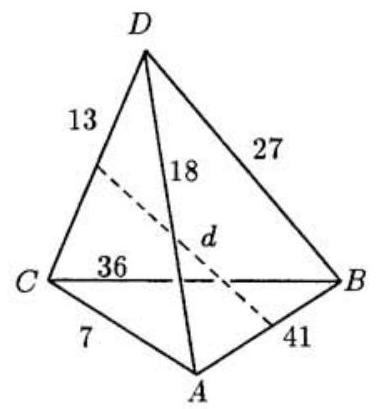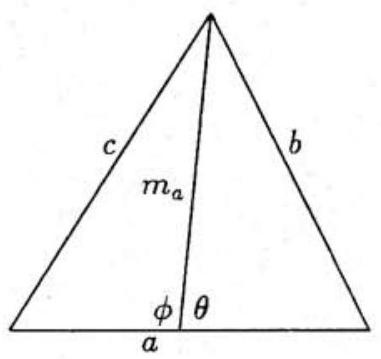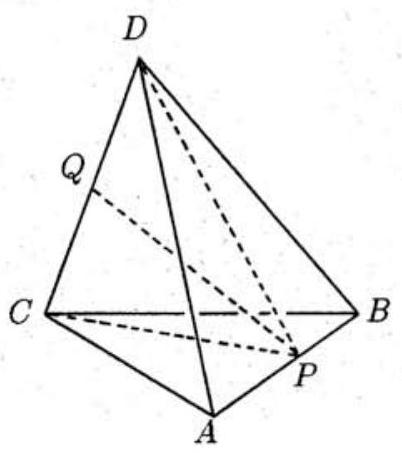Problem:
Let ABCD be a tetrahedron with AB=41, AC=7,AD=18,BC=36,BD=27, and CD=13, as shown in the figure. Let d be the distance between the midpoints of edges AB and CD. Find d2.
Solution:
We first show that if a,b and c are the three sides of a triangle and ma is the median to side a, then
ma2=41(2b2+2c2−a2)(1)
We then apply (1) three times in order to find the desired d2.
To prove (1), consider the figure shown below. Apply the Law of Cosines to each of the two smaller triangles to get
ma2=21(ma2+ma2)=21[(c2−41a2+amacosϕ)+(b2−41a2+amacosθ)]=41(2b2+2c2−a2)+21ama(cosϕ+cos(π−ϕ))=41(2b2+2c2−a2)
Next, in the tetrahedron shown below, let P be the midpoint of AB and Q be the midpoint of CD. We apply (1) to find (PC)2 (since PC is a median of △ABC) and (PD)2 (since PD is a median of △ABD). We find
(PC)2=41[2(AC)2+2(BC)2−(AB)2]=41009
and
(PD)2=41[2(AD)2+2(BD)2−(AB)2]=4425
Finally, we again use (1) to find d2=(PQ)2 from △CDP:
(PQ)2=41[2(PC)2+2(PD)2−(CD)2]=137
OR
Introduce the vectors u,v and w to denote the directed edges from A. (See the accompanying figure.) The other three edges, with orientations as indicated, are given by u−v, u−w and v−w. Moreover, the vector from A to the midpoint of AB is 21u and the vector from A to the midpoint of CD is 21(v+w). Consequently, the vector from the midpoint of CD to the midpoint of AB is 21u−21(v+w). We seek the square of the length of this last vector.
Recalling that for a vector x,∣x∣2=x⋅x, we have
d2=41(u−v−w)⋅(u−v−w)=41(∣u∣2+∣v∣2+∣w∣2−2u⋅v−2u⋅w+2v⋅w)(1)
To find u⋅v,u⋅w and v⋅w, note that ∣x−y∣2=∣x∣2+∣y∣2−2x⋅y, which implies
2x⋅y=∣x∣2+∣y∣2−∣x−y∣2(2)
Applying (2) to (1) yields the general formula
d2=41(∣v∣2+∣w∣2+∣u−v∣2+∣u−w∣2−∣u∣2−∣v−w∣2)(3)
The given measurements yield d2=137.
The problems on this page are the property of the MAA's American Mathematics Competitions



.jpg)